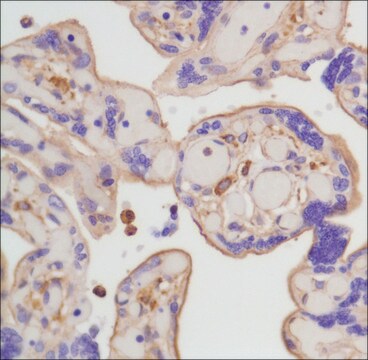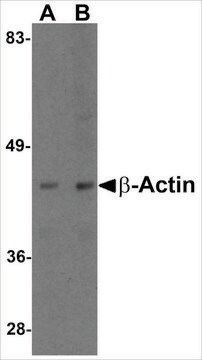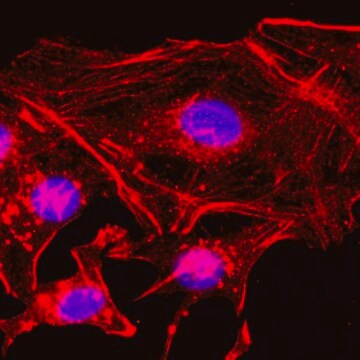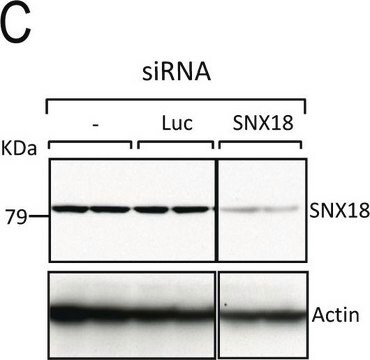ABT264
Anti-beta Actin Antibody, arginylated (N-terminal)
from rabbit, purified by affinity chromatography
Synonyme(s) :
Actin, cytoplasmic 1, arginylated, beta Actin, arginylated
About This Item
Produits recommandés
Source biologique
rabbit
Niveau de qualité
Forme d'anticorps
affinity isolated antibody
Type de produit anticorps
primary antibodies
Clone
polyclonal
Produit purifié par
affinity chromatography
Espèces réactives
mouse, rat, human
Réactivité de l'espèce (prédite par homologie)
orangutan (based on 100% sequence homology), canine (based on 100% sequence homology), rabbit (based on 100% sequence homology), hamster (based on 100% sequence homology)
Technique(s)
dot blot: suitable
immunocytochemistry: suitable
western blot: suitable
Numéro d'accès NCBI
Numéro d'accès UniProt
Conditions d'expédition
wet ice
Modification post-traductionnelle de la cible
unmodified
Informations sur le gène
human ... ACTB(60)
Description générale
Spécificité
Immunogène
Application
Western Blotting Analysis: 2.0 µg/mL from a representative lot detected N-terminally arginylated beta actin in human (HeLa, HEK293, HepG2, HUVEC, Jurkat, PC3), rat (PC-12 pheochromocytoma), and murine (C2C12 myoblast, NIH/3T3, and Raw 264.7) cell lysates, as well as in human placenta and mouse brain tissue homogenates.
Dot Blot Analysis: 0.2 µg/mL from a representative lot detected immunogen peptide, but not the corresponding peptide without the N-terminus arginine (Courtesy of Dr. Anna Kashina, University of Pennsylvania, Philadelphia, PA).
Western Blotting Analysis: 0.2 µg/mL from a representative lot detected greatly reduced beta actin N-terminal arginylation modification in Arg-transfer RNA (Arg-tRNA) protein transferase (Ate1) knockout mouse embryonic fibroblasts (Courtesy of Dr. Anna Kashina, University of Pennsylvania, Philadelphia, PA).
Note: Goat serum is found to interfere with the staining by this polyclonal antibody, BSA is recommended for sample blocking when using this product.
Cell Structure
Cytoskeleton
Qualité
Western Blotting Analysis: 2.0 µg/mL of this antibody detected N-terminally arginylated beta actin in human A431 cell lysate.
Description de la cible
Forme physique
Stockage et stabilité
Autres remarques
Clause de non-responsabilité
Vous ne trouvez pas le bon produit ?
Essayez notre Outil de sélection de produits.
En option
Code de la classe de stockage
12 - Non Combustible Liquids
Classe de danger pour l'eau (WGK)
WGK 1
Point d'éclair (°F)
Not applicable
Point d'éclair (°C)
Not applicable
Certificats d'analyse (COA)
Recherchez un Certificats d'analyse (COA) en saisissant le numéro de lot du produit. Les numéros de lot figurent sur l'étiquette du produit après les mots "Lot" ou "Batch".
Déjà en possession de ce produit ?
Retrouvez la documentation relative aux produits que vous avez récemment achetés dans la Bibliothèque de documents.
Les clients ont également consulté
Notre équipe de scientifiques dispose d'une expérience dans tous les secteurs de la recherche, notamment en sciences de la vie, science des matériaux, synthèse chimique, chromatographie, analyse et dans de nombreux autres domaines..
Contacter notre Service technique









